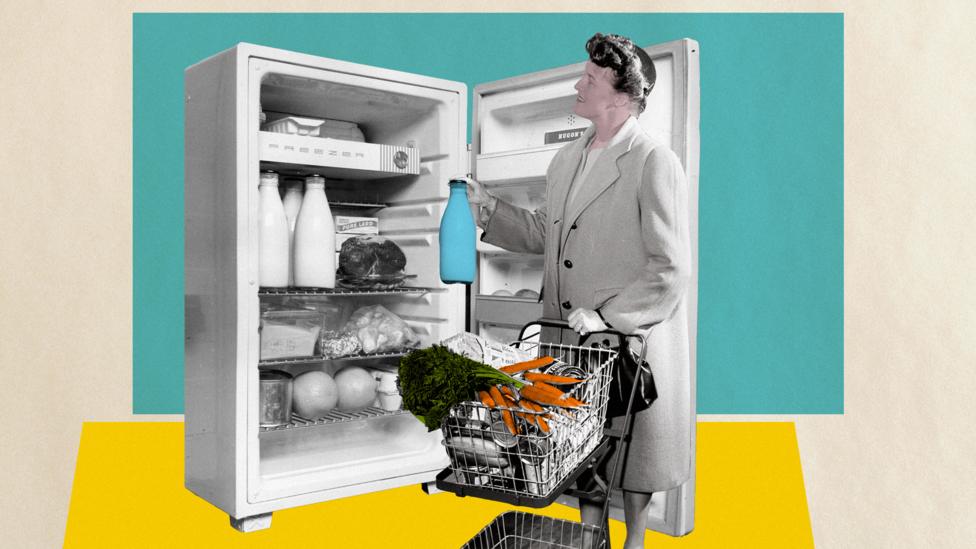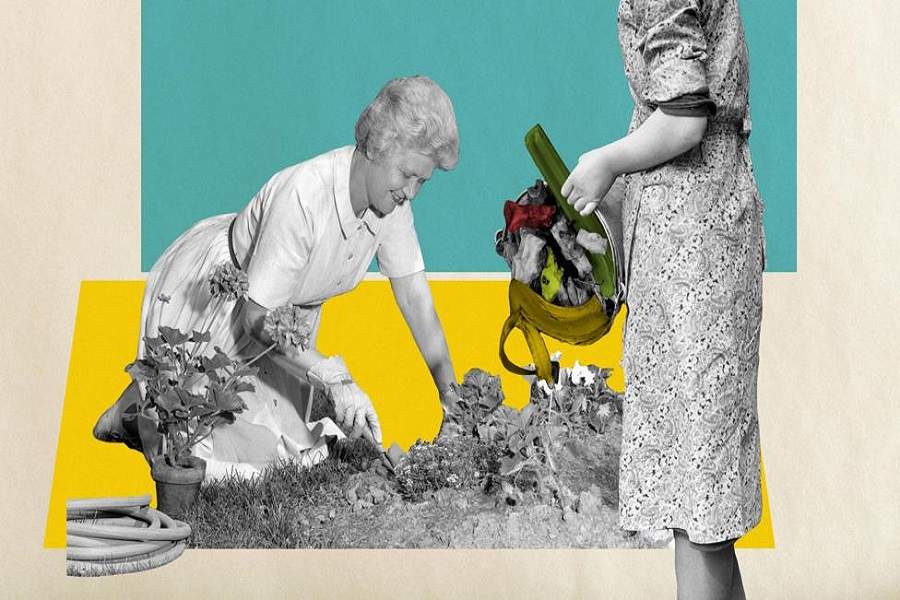All food generates greenhouse gases to reach our plates, but when nearly a third of it is thrown away or wasted, does that mean we could be doing more to protect the climate?
How much did you leave on your plate last time you ate? A few scrapings? A couple of rogue chips? Or perhaps even a few mouthfuls you were too stuffed to finish off?
It is worth considering, then, that every time you throw leftovers away, you’re not just binning tomorrow’s lunch – each forkful of food was responsible for greenhouse gas emissions before it even got to your plate. Growing, processing, packaging and transporting the food we eat all contributes to climate change. And then when we throw it away, as it rots it releases yet more greenhouse gases into the atmosphere.
It has been estimated that if food waste was a country, it would be the third highest emitter of greenhouse gases after the US and China, according to the Food and Agriculture Organization (FAO) of the United Nations. One third of greenhouse emissions globally come from agriculture, and 30% of the food we produce is wasted – about 1.8 billion tonnes of it a year. If, as a planet, we stopped wasting food altogether, we’d eliminate 8% of our total emissions.
Of course, individual households aren’t to blame for all of this waste. A 2018 study found that about a third of our fruit and veg is rejected for being the wrong size or shape before it even reaches the supermarket shelf, for example. (Read more about how the food chain is being redesigned to cut down on waste.)
Where food is most wasted differs across the world. In low income countries, 40% of food is wasted after it’s harvested but before it makes it to people’s homes, usually because of a lack of adequate infrastructure. But in middle- and high-income countries, consumers take a bigger slice of the blame: estimates suggest that households are responsible for 53% of all food waste in Europe, and 47% of food waste in Canada.

It has never been easier for us to get the food we want, when we want, but more than a third of the food we produce is wasted (Credit: Getty Images/Javier Hirschfeld)
The reasons for that waste can vary too – in some parts of the world it is considered polite to leave a small amount of food on the plate to show that the host hasn’t scrimped on portions. Lack of refrigeration is another major cause of waste. But in many developed countries, easy access to abundant supplies of cheap produce has made consumers less thrifty about what they keep in their fridges and put on their plates.
Quantifying exactly how much food we’re wasting at a household level isn’t easy, though. Kate Parizeau, an associate professor at the University of Guelph, and colleagues ran a study in Canada that involved digging through all the rubbish generated by 94 families living in Guelph, Ontario. They categorised the food they found based on how edible it was and how much of it there was. They discovered that each family threw out around 3kg of avoidable food waste each week, equivalent to 23.3kg of carbon emissions. Figures for the UK are comparable, with 68kg of food wasted at home each year per person, according to 2020 data from the British waste and recycling charity Wrap.
But not many studies, or indeed individuals, choose to delve this deep into our bins. And when people are asked to record what they waste in diaries, they tend to under report what they are throwing in the bin.
There’s so much edible food that ends up in the trash – Kate Parizeau
“I don’t think people are completely aware of [the climate impacts of food waste],” says Mattias Eriksson, who researches food waste at the Swedish University of Agricultural Sciences in Uppsala. “But I think the problem is even bigger, because most people, they don’t actually waste food, according to themselves.”
But a lack of precise data shouldn’t stop us trying to tackle the problem, says Parizeau. “We know just by the audits that we’ve done, it is excessive,” she says. “There’s so much edible food that ends up in the trash.”
By simply rethinking how you shop and cook, in most high income countries at least, it should be possible to reduce the amount we waste and so lessen our contribution to climate change.
“We know that there’s a whole bunch we can do at the household level,” says Parizeau.

Throwing away 3kg of edible food results in greenhouse gases equivalent to 23kg of carbon dioxide being emitted into the atmosphere (Credit: Getty Images/Javier Hirschfeld)
Anne-Marie Bonneau, a book editor based in California and author of the Zero Waste Chef blog, started thinking seriously about food waste after learning that up to 40% of the food produced in the US isn’t eaten. “My mouth fell open,” she says.
Now, Bonneau estimates that she’s cut her food waste to almost zero, composting scraps like tea leaves, eggshells and citrus peels, and using up everything else. “I try to keep our inventory small enough that I don’t throw out food, and large enough that we have enough food to eat,” she says. “If I can’t get to something before it will go south, I freeze it.”
Achieving that level of waste reduction isn’t easy, but Bonneau recommends starting with a few simple steps. If you can’t already cook, she says, learn to make some simple meals, like soups. Then, start checking what you have at home already before going to buy ingredients. “Instead of surfing the internet and finding a recipe that looks good or going through cookbooks, first look at the food you have on hand,” she says.
This suggestion is also backed by research. “Checking inventory is a big one,” says Parizeau. “Often people will have habitual shopping habits. You go to the store, you buy a loaf of bread every week – but maybe you already have some in the freezer.”
A 2018 study found that fresh vegetables and salad make up 25% of edible household food waste in the UK
Another effective way to reduce food waste is planning ahead, she adds. When people make shopping lists and meal plans, and stick to those, “that does seem to have a relationship to the amount of food waste” they produce.
Once using up what you already have becomes second nature, you could be saving not just carbon emissions, but potentially time and money, too, by avoiding the need to run to the shops each time you cook dinner. “It’s so satisfying when I make a meal out of almost nothing,” says Bonneau.
Of course, for some of us cooking from scratch and even keeping track of the food already in our fridge is not that easy. “We know there are many reasons why people aren’t able to reduce their food waste,” says Parizeau. Some people want to provide abundance for their families by having a well-stocked fridge, others might be overly-cautious when it comes to food safety and discard food they deem too old, while many people simply struggle to find the time to plan meals at all.

Rather than going to the shops for every meal, using up the produce still in your fridge is a good way to cut down on waste (Credit: Getty Images/Javier Hirschfeld)
To tackle some of these barriers, Parizeau recently worked on a cookbook featuring food waste-reducing recipes that use, for example, a whole head of cauliflower rather than half of one, to avoid leaving people with leftover vegetables that will eventually turn nasty and need to be thrown away. Other recipes can be adapted to whatever vegetables you have on hand.
But not all food waste is equal when it comes to carbon emissions. Meat and dairy products have much higher carbon emissions than fruit and vegetables, so reducing the amount of meat you waste will have a bigger impact than cutting down on throwing out carrots.
A 2018 study found that fresh vegetables and salad make up 25% of edible household food waste in the UK, for example, but only account for 12% of the greenhouse gas emissions from wasted food. On the other hand, meat and fish account for just 8% of wasted food but 19% of emissions.
Similarly, a 2015 study on food waste in Swedish supermarkets found that, though the fruit and vegetable department account for 85% of food wasted by mass over a three year period, that food only made up 46% of the total carbon footprint from wasted food. Meanwhile, meat made up 3.5% of the total mass of food that was discarded, but 29% of the carbon footprint.

Meat makes up a smaller proportion of the food thrown away, but accounts for more of the carbon emissions that come from waste (Credit: Getty Images/Javier Hirschfeld)
“If you want to reduce carbon footprint then beef will be a real target product,” says Eriksson. “There you have super concentrated emissions, so you have a lot of emissions in a few kilos of food waste.”
With this in mind, it’s worth remembering that consumption and waste go hand in hand, says Eriksson. “If you consume a lot, you probably also waste more of that product,” he says. “A vegetarian will not waste any beef, for example, for obvious reasons.”
How you throw your food away also matters. Organic matter rotting in a landfill releases methane, a greenhouse gas several times more potent than carbon dioxide. But if you compost your leftovers in a well-maintained bin that lets in oxygen, you’ll significantly reduce the amount of methane released into the atmosphere and the carbon in the composting organic matter will be held in the resulting soil.
One study estimated that the greenhouse gas emissions from composting are just 14% of the same food dumped into landfill, while Mattias’s own work found the emissions vary depending on the food, but composing bread, for example, would release just 2.2% of the emissions from putting it in landfill. Project Drawdown, a research organisation that identifies potential solutions to climate change, estimates that if composting levels worldwide increased, we could reduce emissions by 2.1 billion tonnes by 2050.

Putting any scraps or unusable leftovers into compost can reduce the amount of methane released into the atmosphere (Credit: Getty Images/Javier Hirschfeld)
“The low hanging fruit in the food system is to move from landfill to anything else,” says Eriksson. “Home composting, anaerobic digestion, incineration, whatever you do, everything is better than landfill.” While there are environmental differences between those other disposal methods, the magnitude is much smaller. So if your leftovers currently go in the bin, it’s worth considering whether you can change that.
If you don’t have a garden at home, you could check whether you can get your food waste collected from your home for industrial composting instead. The UK has set out plans to offer weekly food waste collections by 2023, for example, and many local authorities already do so to reduce the amount of food that ends up in landfill. In some countries, like Denmark, sending organic waste to landfill is already banned.
If composting levels worldwide increased, we could reduce emissions by 2.1 billion tonnes by 2050
Still, the biggest change most people in high income countries could make is to stop buying too much food in the first place, says Eriksson. Eventually, a reduction in demand could lead us to a system where we no longer produce more food than we need. “For most people, at least in the Western world, consuming less will be something that they can actually contribute with,” says Eriksson. “It is our consumption that drives the whole problem.”
If your own contribution to that problem seems like a drop in the ocean, don’t think of your actions in isolation. “As people start to care more about food waste in their household, they become more informed citizens,” says Parizeau. “They ask questions about how the food system works, and they ask for regulation to reduce waste across the entire system.”
It may take some effort, but cutting the amount of food you throw away can have a real impact on the planet.
Source: BBc Future

